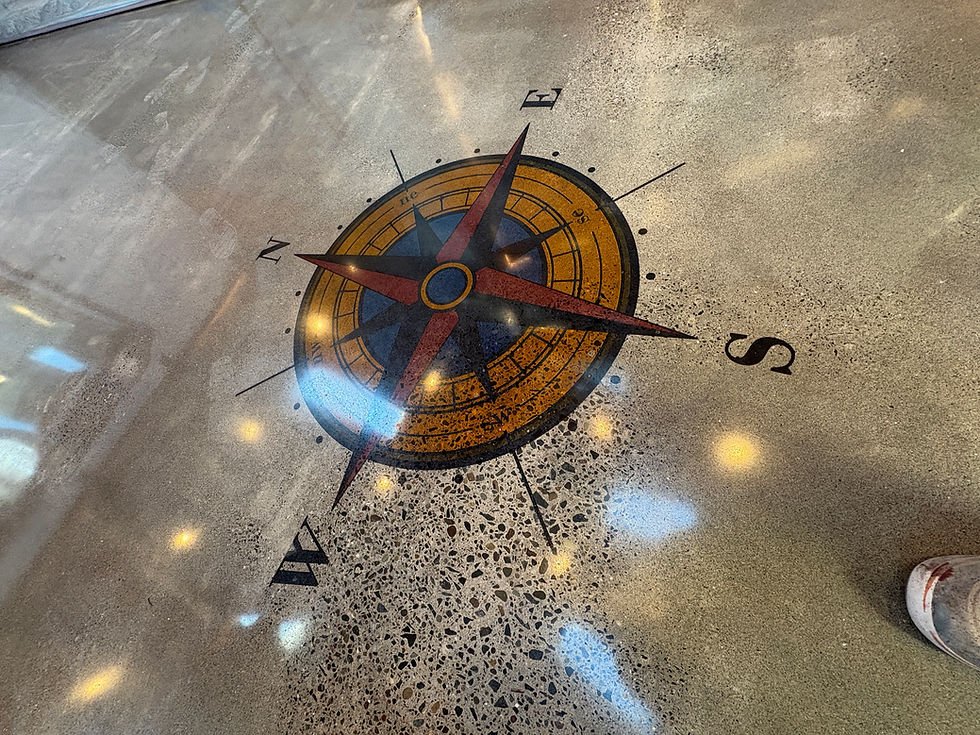Bringing Color to Polished Concrete: Using Acetone Dyes
- rockwelsurfacea
- Aug 17
- 2 min read
Polished concrete has become a favorite flooring choice for homeowners, designers, and contractors alike. It’s durable, low-maintenance, and versatile. But what really sets polished concrete apart is its ability to transform into a true design feature—and one of the most popular ways to do that is with acetone dyes.
What Are Acetone Dyes?
Acetone dyes are ultra-fine color pigments dissolved into a fast-evaporating solvent (acetone). Unlike traditional acid stains, which react chemically with the concrete, acetone dyes penetrate deep into the surface pores to create vibrant, consistent color. This allows for a wider color range, faster application, and fewer surprises during installation.
Why Use Acetone Dyes on Polished Concrete?
Color Variety – From rich earth tones to bold modern shades, acetone dyes offer more flexibility than acid stains or integral color.
Fast Drying – Because acetone evaporates quickly, the dye sets almost instantly, keeping projects on schedule.
UV-Stable Options – While some dyes are best for interiors, UV-stable versions hold up to sunlight exposure, making them great for patios or outdoor spaces.
Layering & Blending – Multiple coats can be applied for depth, or colors can be blended for custom looks like marbling or mottling.
The Application Process
Surface Prep – The concrete must be properly ground and cleaned so the dye can absorb evenly. Any dirt, oil, or coating left behind will block penetration.
Polishing Stages – Typically, dye is applied after the concrete has been polished to a mid-grit (usually around 400 grit). This allows the surface to be open enough for absorption while still providing a smooth base.
Spray Application – The dye is sprayed in light, even coats. Contractors often use overlapping passes to prevent streaking.
Sealing the Color – A densifier and guard or sealer are applied to lock in the dye and enhance the polished finish. This ensures the floor not only looks great but also stands up to foot traffic and spills.
Design Possibilities
Logos & Graphics – With stencils, acetone dyes can be used to create company logos, borders, or custom artwork in the concrete.
Two-Tone Floors – Contrasting shades can define spaces without walls, perfect for open floor plans.
Subtle Enhancements – Even a single layer of dye can take a gray slab from industrial to refined.
Things to Keep in Mind
Acetone dyes are semi-transparent, so they highlight the natural character of the concrete rather than covering it up.
Every slab takes dye differently depending on porosity and age. Test samples are always recommended.
Proper sealing is key. Without it, the dye can fade or wash out over time.
Final Thoughts
Acetone dyes are one of the most effective ways to elevate polished concrete from functional flooring to a design statement. Whether you’re looking for a bold, colorful finish or a subtle enhancement, they provide endless possibilities when paired with a professional polish.
At Rockwell Surfaces, we specialize in polished concrete and decorative finishes that combine durability with design. If you’re interested in learning more about adding color to your project, contact us today for a free consultation.






Comments